<BACKNEWS
VOTE FOR THE WATERPOD™ CHICKEN
Waterpod™is an accessible self-reliant eco-habitat, exhibition and living space, constructed with the advancing sea levels in mind. It is a showcase for sustainable attainable grassroots technology and will become an available open source manual of creative solutions and a platform for dialogue, but it is also an exhibition center for contemporary art and an art installation in and of itself. We need to choose what kind of chickens we are going to have on the pod, and you can help us decide. If Waterpod™ were a chicken, what kind of chicken would she be?
JUST CLICK BELOW TO SEND US AN EMAIL WITH YOUR CHOICE >>
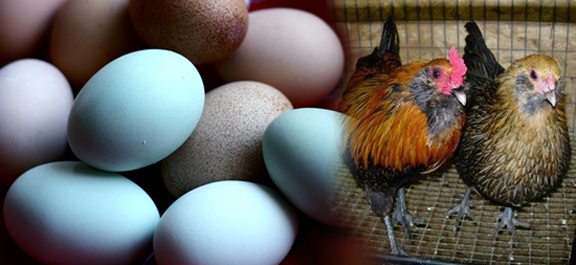
-Left to Right: Eggs, including blue Ameraucana eggs, and an Ameraucana rooster and hen.
1. Novel, artistic, unusual, and lovely to live with >> click above image to vote
Ameraucana, Araucana, Rumpless Araucana or Easter Eggers
The Araucana and Rumpless Araucana were introduced from Chile in 1921, from one of several different blue egg-laying chicken breeds. In pre-Columbian Chile, there were several different blue egg-laying chicken breeds, none called Araucana. It is likely that some "mongrelization" occurred before standardization. The Araucana as we know it today is a hybrid of two South American breeds: the Collonca (a naturally blue-egg laying, rumpless, clean-faced chicken) and the Quetros (a pinkish-brown egg layer that is tailed and has ear-tufts). The truest bred carry a "lethal gene" which is also connected to their tufting characteristic, though standards differ internationally. They are well adaptable to confinement or free range, are naturally calm and non-aggressive. They lay blue eggs only . There has long been debate whether araucanas were bred from chickens brought by Europeans to South America after Columbus or rather arose from chickens brought directly over the Pacific Ocean from someplace nearer to all chickens' presumed ancestral home in Southeast Asia. If araucanas predate the Europeans in South America, their presence implies pre-Columbian trans-Pacific contacts between Asia and South America. The Ameraucana may or may not be genetically related to the Araucana. The Ameraucana breed became standardized and accepted into the American Poultry Association in 1984. They tend to be well adapted to confinement or free range and are mostly calm and non-aggressive. They lay medium sized eggs in various shades of blue and blue-green. Like the Araucana and Rumpless Araucana, Ameraucana are good brooders and very cold hardy. Most hatcheries, however, sell Easter Egg chickens with mixed breeding that may lay blue, green (or other colored) eggs, but do not conform to standard. The personality of mongrel Easter Eggers is widely varied, some are aloof, while others are very friendly and easily handled.
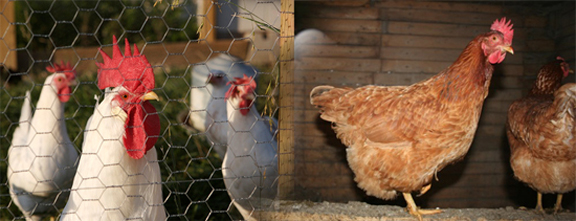
-Left to Right: Leghorn, Rhode Island Red.
2. Classic, economical, efficient, and can foretell the future >> click above image to vote
The Leghorn and the Rhode Island Red
The Leghorn is renowned as the ultimate egg machine. It is an ancient breed, which was greatly developed in the 19th and 20th centuries. The Leghorn was honored by the ancient Romans, and the white variety was reportedly developed for use in ceremony for foretelling the future. It remains one of the most popular birds on the planet. It is an economical eater, and better adapted to confinement then some Mediterranean breeds. It is a flyer that enjoys free range. It is flighty, spritely, noisy, nervous, and usually avoids human contact. It is hardy and heat tolerant. The Leghorn lays medium to large pearl colored eggs. Due to their prolific egg-laying, they are preferred by laboratories for embryonic and avian biological research as well as being the number one breed used for large-scale commercial egg production in the United States. The Rhode Island Red is a hardy robust breed well adapted to confinement or free range developed in New England in the 19th century. They are known as the best of all chicken breeds for producing brown eggs. The Rhode Island Red is active, calm and fairly docile, though it can be aggressive. The cocks are especially notorious for aggressiveness. They are a popular choice for backyard flocks because of their egg laying abilities and hardiness. They lay large, rich brown eggs and are heat tolerant.
Why are Chicken Eggs Different Colors?
wisegeek.com
Chicken eggs from various chicken breeds emerge in different shades because of pigments which are deposited as the eggs move through the hen's oviduct. The pigment depositions are determined by the chicken's genetics, with some breeds producing rich dark brown eggs, for example, while others lay snow white eggs. The eggs inside are essentially identical; there are no major flavor differences between chicken eggs from different birds, as the flavor is determined by the chicken's diet.
There are three main colors for chicken eggs. Most eggs in the store come in white or shades of brown. It is also possible to find blue to green chicken eggs, which come from the Aracuana, a breed of chicken developed in Chile. Araucanas have also been crossed with other breeds to produce the Americauna, sometimes called the “Easter egg chicken” in a reference to its multicolored eggs.
Originally, all chicken eggs were probably brown. Over time, people selectively bred chickens with progressively lighter eggs, ultimately producing white chicken eggs, which came to be the norm. Brown eggs were reintroduced to the market in the late 20th century, although people on farms were already quite familiar with the them. Some classic white egg laying breeds include Andalusians, Faverolles, Dorkings, Leghorns, and Lakenvelders. Barnevelders, Rhode Island Reds, Jersey Giants, Delawares, and Orpingtons are well known for their brown eggs, which vary in color from light cream to dark brown.
In many cases, a chicken with white ear lobes will produce white eggs, while chickens with red ear lobes lay brown eggs, although this is not always true. Size is not a determining factor, with white eggs coming from tiny Bantams just as they do from large Leghorns. The color of the chicken is also irrelevant; chickens actually come in a wide range of shapes, colors, and sizes which run the gamut from strange-looking Frizzled Cochins to sleek black and white Lakenvelders.
The color of chicken eggs should not influence your purchasing decisions at the market, as the contents of the egg are what counts. Chickens who eat free range, varied diets tend to produce healthier eggs, as their free range lifestyles allow them to consume the dietary minerals they need for their own health, and these minerals will be passed down in their eggs. You may also have noticed that farm-fresh eggs have very dark yolks, whereas chicken eggs from battery hens have much lighter yolks, indicating less nutritional value.
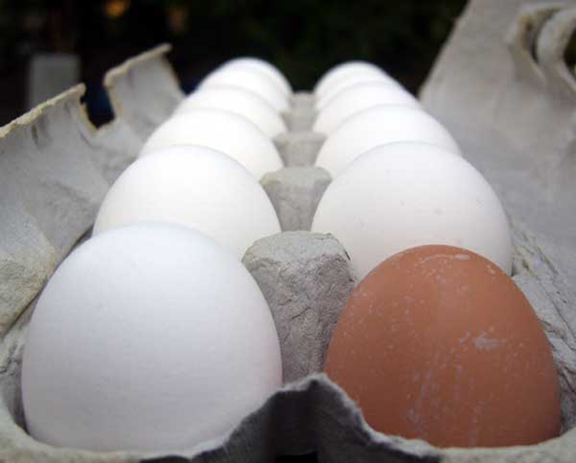
Join Waterpod™'s Ongoing Growing Project by Starting Seeds for Our Garden
To be involved all you have to do is :
1. Love seed propagation and germination.
2. Have access to email/camera to send photo updates of your seedlings.
3. Be able to nurture seedlings for 2-5 kinds of seedlings for 2-10 weeks while barge construction is happening.
4. You have some of your favorite seeds that you can't wait to germinate or share.
5. Be excited about joining the Waterpod Living Systems team.
6. Contact Waterpod Livingsystems director Carissa Carman through her blog waterpodlivingsystems.blogspot.com: tell her where you live and your level of expertise in special needs seeds or easy to grow seeds.
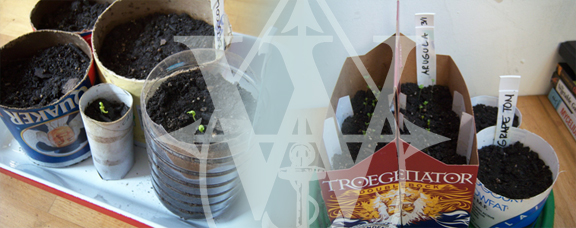
-images taken from waterpodlivingsystems.blogspot.com.
APRIL 2009: Sustainable Technology on Waterpod™
Waterpod™ and Humboldt State University Engineering Class 215 Connection. Ever imagine cooking dinner on a rocket stove? Find out how Lonny Grafman of Appropedia, the sustainable wiki, and his class of keen engineering students from Humboldt State University imagine Waterpod™>>
Nomadographies April 2 - May 23 2009
Mary Mattingly, the conceptual artist and primary creative force behind Waterpod™ currently has an photographic installation titled Nomadographies April 2 - May 23 2009 on exhibit at Robert Mann Gallery, 210 Eleventh Avenue (between 24th & 25th Streets) New York, NY.
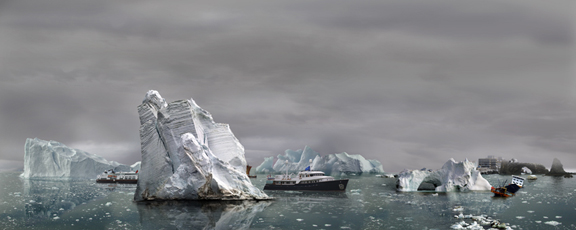
-image by Mary Mattingly, 2009.
Waterpod™ Living Systems Team
Right now, as true to form urbanite, we need help in starting groups of seeds. Which means, we are creating a garden family, not so much a community garden, but yes! we will all be growing seeds all around the city and when the frost passes and the barge is filled with delicious soil, we will come together for a BIG planting session.
TO BE INVOLVED ALL YOU HAVE TO DO IS:
1. Love seed propagation and germination.
2. Have access to email/camera to send photo updates of your seedlings.
3. Be able to nurture seedlings for 2-5 kinds of seedlings for 2-10 weeks while barge construction is happening.
4. You have some of your favorite seeds that you can't wait to germinate or share.
5. Be excited about joining the Waterpod Living Systems team.
6. Email Living Systems Manager Carissa Carman: carissacarman@gmail.com
telling me where you live and your level of expertise in special needs seeds or easy to grow seeds.
FEBRUARY 2009: WATERPOD™ IN THE WORLD
Construction of Waterpod™ has begun on both coasts. Lonny Grafman, an Instructor of Environmental Resources Engineering and Appropriate Technology at Humboldt State University, is our West Coast sustainability consultant and has been leading his class of engineering students to tackle many of the aspects of living self-sufficiently on Waterpod™ including harnessing bicycle power, composting toilet technology, hydroponic growing systems, and water filtration. In New York, our lead builder Derek Hunter and the core Waterpod™ team have been working gathering salvaged materials and beginning the modular construction of the central dome structures.
Waterpod™ Living Systems Blog>>
The Waterpod™ team has created a living systems department to spearhead the organization and design of the edible landscape area that will include fruits vegetables, herbs and flowers as well as a 20’ x 20’ domed greenhouse. The role of the living systems is instrumental in the formation of an active and reliant system for developing and nourishing self-sufficiency. Considerations for the following details are managed into the planning, care and maintenance of the garden areas:
· Using local, Hierloom seeds and supporting seed banks.
· Thoughtful, efficient low watering needs.
· Introducing diversity and native plants to encourage local pollinators.
· Companion planting for pest management.
· Run-off prevention as a city/environmental responsibility.
· Xeri-scaping low water/green roof plants for education.
· Enhancing garden nutrients with waste decomposition.
|
-Illustration by Carissa Carman.
New Renderings from Lux Visual Effects of Waterpod™
Renderings of the Waterpod™ artist residency building, public and edible garden spaces have been added to the image gallery>>
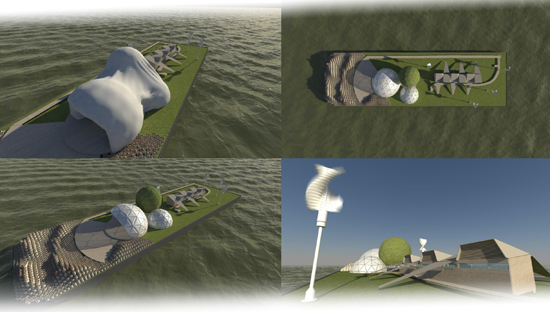
-Rendering by James Halverson.
YOUR SUPPORT IS NEEDED
Water, and how we manage our water resources, is already defining this century. In a time of uncertain futures, Waterpod™ project attempts to create a futuristic, autonomous space that promotes community interaction and involvement, combines art, life on the water, and new ideas in architecture and environmentally friendly technologies.
Waterpod™ needs your support. Waterpod™ is fiscally sponsored by Action Arts League, a 501 (c) 3 not-for-profit organization. Waterpod™ is a not-for-profit project and actively supports organizations that provide in-kind goods or services, supplying signage, acknowledgements, and other emoluments based on contribution level.
To donate to Waterpod™ Project please click the link below >>
justgive.org
Thank you.
WATERPOD™ IN THE PRESS
As the construction progresses on the foundation barge in New York, people are beginning to talk about Waterpod™ Project >>
January 2009: New Year
The Waterpod™ team is busy preparing for the hard and exciting work ahead. We are happy to be adding a new section to the website for our official COLLABORATORS. So far, Veronica Flores, a visual artist and builder from Guadalajara and Mara Haseltine, a Brooklyn-based artist with a love for the natural sciences, have both joined the project. Haseltine is responsible for the creation of a Contemporary Oyster Midden and a Mineral Pool onboard the Waterpod™ >>
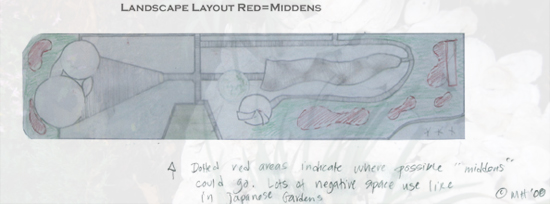
-Illustration of the Oyster Midden by Mara Haseltine.
New inital sketches for the 3D renderings of Waterpod™>>
Thanks to James Halverson of Vancouver based Lux Visual Effects Inc.
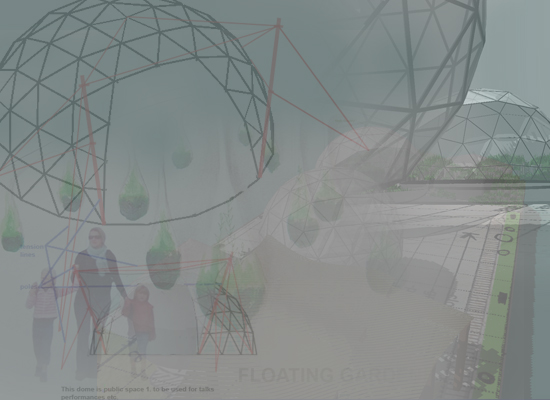
DECEMBER 2008: SALVAGE OPERATION
With help from the Mayor's office, Coast Guard, Parks Department, Dockmaster Unit, and Blank Rome, a firm specializing in Maritime Law, Waterpod™ project is moving along at full speed. The Parks Department has donated growing material, a shipping container, and other building materials and tools to the project.
Derek Hunter and Mary Mattingly have been working at a space out in Floyd Bennett Field, documenting the work of the Parks Department's Task Force as they retrieve sunken vessels from the waterways. In the Rockaway area alone, there are well over 300 boats that have been left to sink by their owners or by the marinas that are no longer getting storage payment from their owners. Aside from the litter of the boats themselves, in a short amount of time the chemicals from these boats will begin leaching into the water, and they become dangerous obstacles for other boats traversing this area. Many of these boats have to be retrieved and demolished. They have begun salvaging parts from the vessels to re-purpose for Waterpod™.
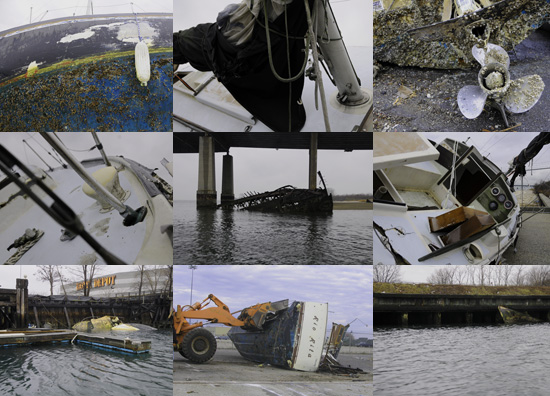
-Photographs by Mary Mattingly.
NOVEMBER 2008: WE HAVE A BARGE
We have a barge and therefore the foundation to start building. Derek Hunter, one of the primary artists and collaborators is currently on his way from Vancouver to New York to begin the construction. Eve K. Tremblay is working from Berlin on the Seed Salon Scenario, Mira Hunter is meeting with the Istanbul MOMA to discuss a possible exhibition before heading out on a tour through Switzerland and the Middle East, while Mary Mattingly is in New York generating more architectural sketches, updated with the new barge proportions >>
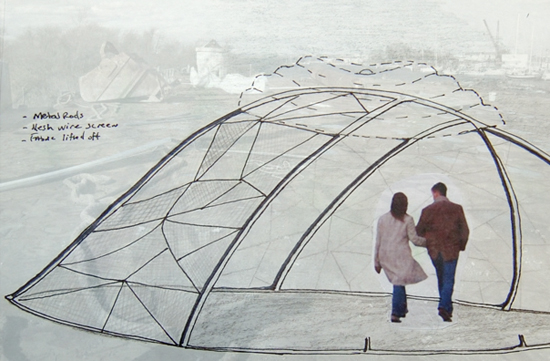
-Sketch of Waterpod™ by Mary Mattingly.
NEW YORK POWOW, AUGUST 30 - SEPTEMBER 08, 2008
MFA, Re-structure, Waterpod Archipelagos Water Parade, Jean-Michel Ross, Occurence Center d'Art et d"Essais Contemporain.
-Eve K. Tremblay and Mary Mattingly have been working in New York on Waterpod™ re-structure with newly found materials. This futuristic re-structure will allow a symbiosis between the architecture and nature, the latter reclaiming its own rights.
An MFA program will be implemented (Mattress for Artist) that will be posted online in 2009, requesting artist applications for potential candidates to live, work, and create on Waterpod™ for an intensive program of up to one week, as well as the Couch Surfing for Writers and Curators Program, matching writers with artists.
Waterpod™ is getting ready to launch a print edition for fundraising (we will have editioned prints available in the spring of 2009), planning for Waterpod™ Archipelagos Water Parade, between New York and Montreal, is underway, meeting of minds: co-curator Jean-Michel Ross from Montreal comes to New York, and on the 10th of September we will re-join in Montreal to work with Occurence Centre d’Art et d’Essais Contemporain with Lily Michaud.
PRIX PICTET, JULY 2008
Mary Mattingly's
photography has been shortlisted for the Prix Pictet
(www.prixpictet.com/artists/)
-The
Prix Pictet is a photographic award centering around
water and ecological sustainability. The work of 17
artists worldwide will be exhibited at the Palais de
Tokyo in Paris, and onto London, Dubai, and beyond.
MAY DAY, 2008
We have re-launched
the Waterpod™ website (www.thewaterpod.org)
with contents including:
-Newtown Creek Audio Walk, revised for the future. Download this podcast for a thirty-minute walk along the Newtown Creek.
-Video documentation of the Beta Launch from the Newtown Creek.
-Documentation of Eve K. Tremblay's performance, The Nomadic Consciousness, where Tremblay recites Ray Bradbury's book Fahrenheit 451.
-Documentation of Mira Hunter's water performance.
-Video interviews with the artists.
>>Waterpod™ Beta




